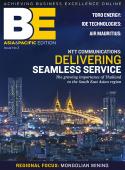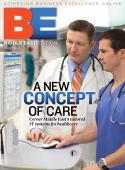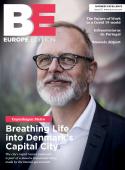A world class goal
South AfricaÔÇÖs Cape Town has a huge programme of improvements planned for its transport system. Looking to FIFA 2010 and beyond, the cityÔÇÖs aim is to provide accessible, affordable public transport for allÔÇöand it is making massive investments to achieve this goal, as Becky Done found out.
As South AfricaÔÇÖs most popular tourist destination, it would stand to reason that Cape Town should be served by a sound, reliable and effective public transport system. Johannesburg may be the countryÔÇÖs largest city but Cape Town is its most densely populated, and thatÔÇÖs another good argument for keeping this metropolis moving. But perhaps the most compelling incentive to provide an excellent public transport system comes from the world of sportÔÇönext year, the city will play host to several of the FIFA 2010 World Cup matches.
FIFA was a catalyst for us to accelerate our plans,ÔÇØ explains Eddie Chinnappen, Cape TownÔÇÖs executive director for Transport, Roads and Stormwater. ÔÇ£If it wasnÔÇÖt for FIFA, we would probably be doing small projects a little at a time. It wouldnÔÇÖt have been as intense.ÔÇØ
And intense it has been, ever since the host nation for FIFA 2010 was announced. ÔÇ£WeÔÇÖve had a programme that weÔÇÖve followed every single day since 2006,ÔÇØ says Chinnappen, ÔÇ£and according to that programme, we are ahead of schedule. IÔÇÖm pleased to say that if you come to Cape Town, youÔÇÖll find some very intense construction activityÔÇöitÔÇÖs really changing the landscape of the city and thatÔÇÖs quite exciting. WeÔÇÖre talking about huge amounts of money.ÔÇØ
The newly-constructed football stadium at Green Point, as well as the fan park and the fan walk, are all situated in the heart of Cape Town next to the world-famous V&A waterfront, one of the cityÔÇÖs most popular tourist spots. The extra footfall that will consequently funnel into this area provides its own set of challenges, and the city has responded on several levels. Firstly, it has restricted vehicle access in the locality and built a R129 million raised traffic circle above a pedestrian underpass, enabling people to walk to and from the stadium in a vehicle-free environment. Already being used to divert traffic, the circle is now more or less complete.
Also under construction are two pedestrian bridges, costing in the region of R33 million and scheduled to be finished by February next year. As well as providing safe access to the stadium, the bridges will also link Green Point with Cape Town Railway Station, enabling visitors to walk or cycle to and from the stadium without having to negotiate the busy roads en route.
However, it is anticipated that most visitors will make their way around the city via the new and much-celebrated bus rapid transit (BRT) system, which plays the starring role both in transport provision for FIFA 2010 and in the cityÔÇÖs wider aspirations for public transport in the future. Currently under construction at a cost of R2.3 billion, Cape TownÔÇÖs BRT system will provide a fast and efficient way for people to move between the airport, the railway station and of course, the stadium. An articulated bus system, BRT operates on the same principles as light rail, with two ÔÇÿcoachÔÇÖ segments set 940mm from the ground making their way between a series of stations. In fact, this particular system has even been designed so it can evolve into light rail if ever required.
Given that each 2010 match day could see an estimated 100,000 extra visitors to the city, Cape TownÔÇÖs roads have also been a key priority. One of the biggest tasks has been the R235 million Hospital Bend project, which aims to improve this notoriously clogged artery of the N2 freeway by increasing capacity for both public and private transport. The N2 forms a vital link between Cape Town International Airport and the city, so it was important that work be carried out well ahead of 2010.
Part of the project has involved the construction of two additional bridges above the freeway at the intersection. ÔÇ£That is an absolutely amazing project,ÔÇØ says Chinnappen. ÔÇ£Instead of the road works making the congestion worse, they have in fact improved the congestion! Rather than doing it the traditional way where you close off the road, put scaffolding up and build the bridge, we decided to go the aerial route. What we did was suspend another mini structure from the top and then lay the concrete, so we didnÔÇÖt interrupt a very busy freeway. That meant we didnÔÇÖt have to divert the road and have people inconvenienced for a period of two years.ÔÇØ
The project that essentially links all the others together ahead of 2010 is the new Transport Management Control Centre, located east of the city centre in the suburb of Goodwood. Costing R150 million, the 6,000 square metre building is due to be completed in November this year. Since response to transport-related incidents may require a combination of actions from any number of different authorities, the control centre will act as a co-ordination point for the various systems in play, such as the freeway management system, the area traffic control system, the public transport information call centre, the BRT management system and the CCTV surveillance network.
Though being the host nation undoubtedly provides a superb springboard for improvements, transport in Cape Town isnÔÇÖt all about 2010. ÔÇ£We have very detailed long-term strategic plans for transport in Cape TownÔÇöthatÔÇÖs transport as a whole, not just public transport,ÔÇØ confirms Chinnappen. ÔÇ£But I am particularly interested in promoting the use of public transport.ÔÇØ
The long-term overall transport strategy is addressed in the cityÔÇÖs Integrated Transport Plan which broadly aims to improve passenger experience, reduce congestion and enable better planning and regulation of transport services in the city. The plan is updated each year and looks at a variety of components, including non-motorised transport, public transport, freight and interaction with the railways and ports. ÔÇ£ItÔÇÖs very comprehensive,ÔÇØ says Chinnappen. ÔÇ£WeÔÇÖve got a 30-year plan; and weÔÇÖre looking at gentrification, corridors and using rail as the backbone of public transport.ÔÇØ
Though the BRT system is intended to be a dominant feature in the cityÔÇÖs overhaul of public transport, 52 per cent of Cape TownÔÇÖs public transport users travel by railÔÇöa relatively high percentageÔÇöso it makes sense to push that agenda as well. Chinnappen and his team are currently in discussions with commuter rail operator Metrorail to improve the service and bring in more trains. ÔÇ£WeÔÇÖre also talking to businesses about discouraging car allowances and weÔÇÖre working on park and ride services with security,ÔÇØ he confirms. ÔÇ£WeÔÇÖre also using a lot of electronic measures to give better transport information to the publicÔÇöfor example, if a train doesnÔÇÖt arrive on time, users can be informed via SMS.ÔÇØ
Though the city is responding and the use of public transport is on the rise, Chinnappen acknowledges it will still take a major push to persuade people to leave their cars. ÔÇ£ItÔÇÖs a major culture change,ÔÇØ he says. ÔÇ£If youÔÇÖve lived in South Africa you will realise that people want to travel by car. I do the same thing: I get into my car through my garageÔÇöthereÔÇÖs a direct link from my houseÔÇöI drive to work, park in the garage and get into the lift. I never have to come into contact with any adverse weather!
ÔÇ£ItÔÇÖs a chicken-and-egg situation,ÔÇØ he continues. ÔÇ£Once you have a decent public transport system, people will use it. So my focus is to make it as easy as possible for people to use public transport.ÔÇØ
But persuading people to leave their cars at home is not only about buses and trains. ÔÇ£YouÔÇÖll find that footways are becoming a priorityÔÇöwe have pedestrianized some streets in Cape TownÔÇöand weÔÇÖve given more attention to cyclists,ÔÇØ says Chinnappen. ÔÇ£IÔÇÖve committed myself within a five year period to build at least 200 kilometres of cycle lanes and weÔÇÖre well on track with that, with 120 kilometres of lanes already constructed.ÔÇØ
Chinnappen has been encouraged by the subtle shift in peopleÔÇÖs priorities prompted by the recession and the rising cost of fuel (he says that South Africa experienced a jump in petrol prices of around 20 per cent at the height of the spike last year). ÔÇ£We have two types of public transport user in Cape Town, or anywhere in the world,ÔÇØ he says. ÔÇ£One is captiveÔÇöwhere they cannot afford a carÔÇöand the other is those who choose to use public transport over private transport. Fortunately in Cape Town, people are very environmentally-conscious.ÔÇØ
Of course, all the improvements in the world can be made to the cityÔÇÖs public transport but if they are not sufficiently supported via targeted promotion that creates visibility, the systemÔÇÖs full potential will never be reached. So Chinnappen and his team have been engaging with the community, encouraging feedback and raising awareness. ÔÇ£WeÔÇÖre creating the first two transport user forums in the city chaired by politicians, so people have the chance to interact. We have lots of pamphlets available and we talk to people at stations,ÔÇØ he explains.
The general mood is one of anticipation, Chinnappen saysÔÇöand not just ahead of 2010. ÔÇ£The public is excitedÔÇöthereÔÇÖs been a very positive response. People are waiting to have a world class public transport system operating in Cape Town.ÔÇØ









